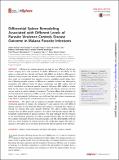Differential Spleen Remodeling Associated with Different Levels of Parasite Virulence Controls Disease Outcome in Malaria Parasite Infections
Author(s)
Huang, Ximei; Huang, Sha; Ong, Lai Chun; Lim, Jason Chu-Shern; Hurst, Rebecca Joan Mary; Mushunje, Annals Tatenda; Matsudaira, Paul Thomas; Han, Jongyoon; Preiser, Peter Rainer; ... Show more Show less
DownloadPublished version (2.233Mb)
Terms of use
Metadata
Show full item recordAbstract
© 2015 Huang et al. Infections by malaria parasites can lead to very different clinical outcomes, ranging from mild symptoms to death. Differences in the ability of the spleen to deal with the infected red blood cells (iRBCs) are linked to differences in virulence. Using virulent and avirulent strains of the rodent malaria parasite Plasmodium yoelii, we investigated how parasite virulence modulates overall spleen function. Following parasite invasion, a difference in parasite virulence was observed in association with different levels of spleen morphology and iRBC rigidity, both of which contributed to enhanced parasite clearance. Moreover, iRBC rigidity as modulated by the spleen was demonstrated to correlate with disease outcome and thus can be used as a robust indicator of virulence. The data indicate that alterations in the biomechanical properties of iRBCs are the result of the complex interaction between host and parasite. Furthermore, we confirmed that early spleen responses are a key factor in directing the clinical outcome of an infection.
Date issued
2016Department
Massachusetts Institute of Technology. Department of Electrical Engineering and Computer Science; Massachusetts Institute of Technology. Department of Biological Engineering; Singapore-MIT Alliance in Research and Technology (SMART)Journal
mSphere
Publisher
American Society for Microbiology